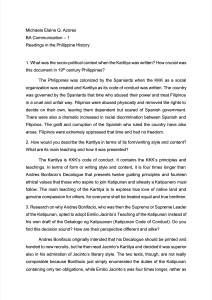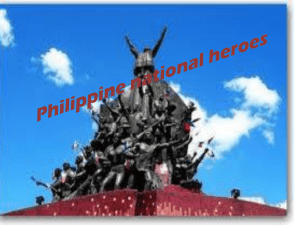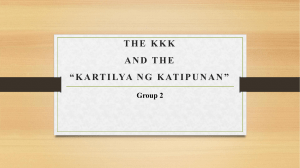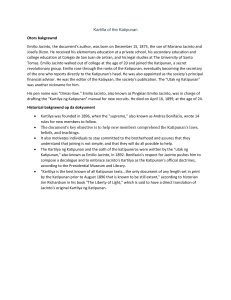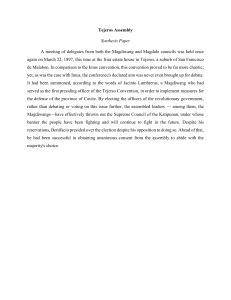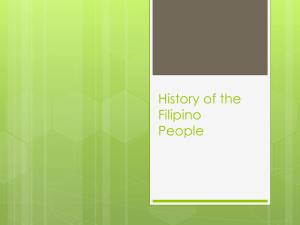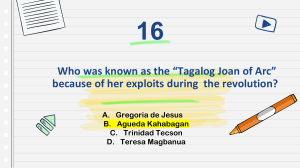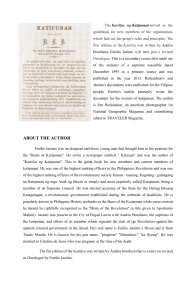Uploaded by
Dan Dominic De Loyola
Katipunan's Decalogue & Kartilya: Impact on Filipino Democracy
advertisement
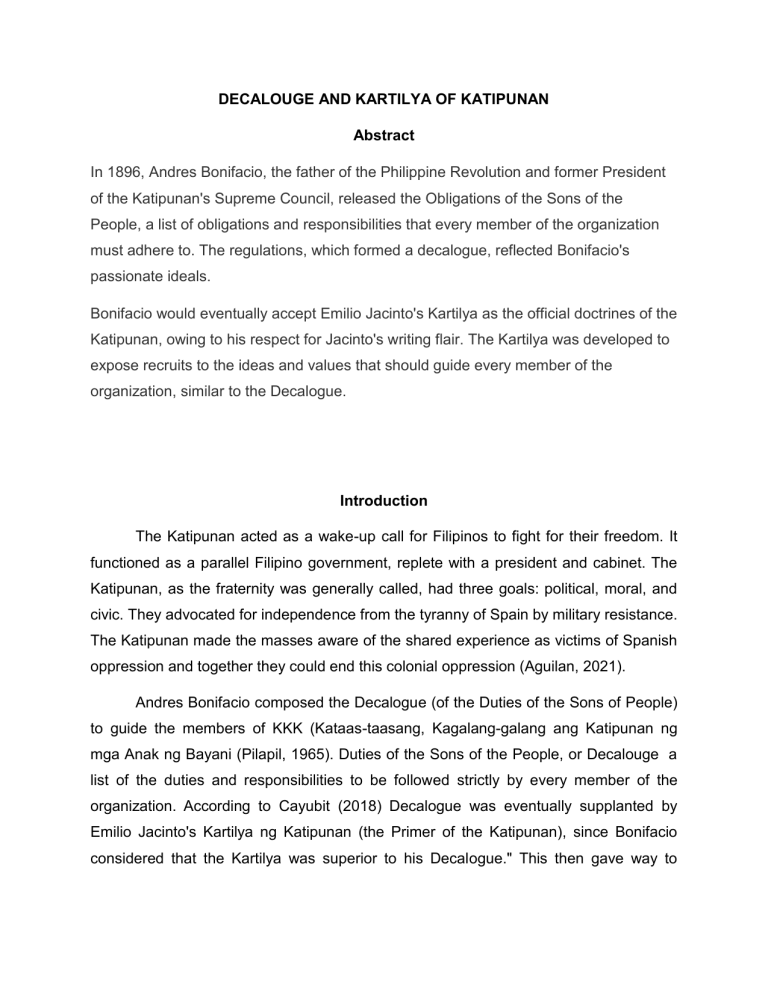
DECALOUGE AND KARTILYA OF KATIPUNAN Abstract In 1896, Andres Bonifacio, the father of the Philippine Revolution and former President of the Katipunan's Supreme Council, released the Obligations of the Sons of the People, a list of obligations and responsibilities that every member of the organization must adhere to. The regulations, which formed a decalogue, reflected Bonifacio's passionate ideals. Bonifacio would eventually accept Emilio Jacinto's Kartilya as the official doctrines of the Katipunan, owing to his respect for Jacinto's writing flair. The Kartilya was developed to expose recruits to the ideas and values that should guide every member of the organization, similar to the Decalogue. Introduction The Katipunan acted as a wake-up call for Filipinos to fight for their freedom. It functioned as a parallel Filipino government, replete with a president and cabinet. The Katipunan, as the fraternity was generally called, had three goals: political, moral, and civic. They advocated for independence from the tyranny of Spain by military resistance. The Katipunan made the masses aware of the shared experience as victims of Spanish oppression and together they could end this colonial oppression (Aguilan, 2021). Andres Bonifacio composed the Decalogue (of the Duties of the Sons of People) to guide the members of KKK (Kataas-taasang, Kagalang-galang ang Katipunan ng mga Anak ng Bayani (Pilapil, 1965). Duties of the Sons of the People, or Decalouge a list of the duties and responsibilities to be followed strictly by every member of the organization. According to Cayubit (2018) Decalogue was eventually supplanted by Emilio Jacinto's Kartilya ng Katipunan (the Primer of the Katipunan), since Bonifacio considered that the Kartilya was superior to his Decalogue." This then gave way to Apolinario Mabini's 'The True Decalogue,' released under the authority of Emilio Aguinaldo. The purpose of this paper is to show how the lessons from the Katipunan, certainly the Decalogue and the Kartilya, affected current Filipino perspectives on democracy. The author will argue that our concept of democracy, as presented by the Katipunan in their Decalogue and the Kartilya, has been disconnected from its historical foundations and the moral standards to which early Filipinos were supposed to comply. This might be the reason why ordinary Filipinos now much cherish our contemporary democracy and why Filipinos have strong links to traditional moral ideals. RRL-3 According to the Philippine Center for Masonic Studies the Katipunan was more than just a call for liberty. It was a national dream come true. It sparked the interest of ordinary people who were prepared to risk their lives and overcome their fear of retaliation, knowing that a worse destiny awaited their family if they did not stand up to their oppressors. It was a secret organization with a formal structure made up of a supreme council and local councils, as well as a membership process that was sometimes confused with Masonry. It also had an ideology, which was expressed in Emilio Jacinto's Ang Kartilya ng Katipunan and Apolinario Mabini’s Decalogue. In the analysis conducted by Mabaquiao (2021) he stated that Mabini's work advocates for a universalist type of nationalism, employs both instrumentalist and noninstrumentalist types of argumentation to advance certain views on the morality of nationalism, and anticipates some of the critical considerations in reconciling national partiality with moral universalism. Mabini's work is demonstrated to be more than just a collection of patriotic injunctions since it is also a cohesive philosophical work that gives a moral basis for nationalism that is still relevant today. On the other hand, Emilio Jacinto of the Katipunan Kartilya described freedom as equality brought about by the emergence of katuwiran. In the True Decalogue, Apolinario Mabini defined freedom as the right to all means of existence, but always in conformity with katuwiran. Moreover, respect for women is so deeply ingrained in Filipino culture that Emilio Jacinto wrote in the Katipunan's Kartilya: "Look not upm woman as a plaything alone, but as one who shares with you the sufferings of this life; be careful of her weakness; remember the mother who bore you and gave you suck." "On the thorny path of life, it is the man who leads his wife and children; if he who leads goes after evil, so will those who follow him," he wrote. Jacinto's Filipino version of the Golden Rule: "Do not do to the wife, daughter, or sister of another what you would not do to your own wife, daughter, or sister.", as said by Grospe (1997). BODY OF THE PAPER For a long time, the Katipunan was best remembered by schoolchildren in Gregorio F. Zaide's history textbook for the so-called August 26, 1896 Cry of Balintawak—a monumental and dramatic event rendered personal by the mass shredding of cedulas. Alternative historians, like as Teodoro Agoncillo, eventually questioned this claim (his version was August 23, 1896 near Pugad Lawin), and the date and location of its true occurrence quickly became a national issue as other tales arose. The Decalogue was just 10 points long and focused on one's responsibilities to God, nation, family, neighbor, the Katipunan, and himself. It talked of honor, generosity, and self-sacrifice, but it also cautioned about the consequences for traitors and disobedients. Instead of just replicating human rights and equality, Jacinto and Bonifacio altered and changed it to better implant it in the minds and emotions of Katipunan adherents. As said by Lissa Guerero Nakpil the Decalogue clearly states that the Katipunan's mission is to free the country from enslavement." No doubt, the Decalogue "marked the earliest formulation of the ideals, goals, and vision for greatness of the first democratic struggle — mass-based movement in all of Asia against a formidable European colonial regime, the Spanish empire." It had such an impact on the Philippine Revolution that a second work, Emilio Jacinto's 'Kartilya ng Katipunan,' was written in response. The Kartilya, on the other hand was more literary and philosophical in nature. It offered its vision of virtuous life as self-reflective teachings rather than outright recommendations. It claimed that human excellence is determined by internal rather than external factors. Jacinto characterized authentic piety (kabanalan) in the third statement as generosity, love for one another, and behaviors, deeds, and speech guided by prudent arguments. The Kartilya, written more than a century ago when nationhood was only a pipe dream, expressed a vision of a "bright sun of freedom among the islands, casting its light onto brothers and a race united. CONCLUSION References: Aguilan, V. (October, 2021).The Relevance of the Katipunan in the Struggle for Philippine Democracy Today. https://www.researchgate.net/publication/355982769_The_Relevance_of_the_Katipuna n_in_the_Struggle_for_Philippine_Democracy_Today Pilapil, V. R. (1965). The cause of the Philippine Revolution. Pacific Historical Review, 34(3), 249–264. https://doi.org/10.2307/3636522 Cayubit, R. (2018). Core values. Manila Bulletin. https://mb.com.ph/2018/01/22/corevalues/ Mabaquiao, N. (March, 2021). Mabini’s “True Decalogue” and the Morality of Nationalism. https://www.researchgate.net/profile/Napoleon-Jr- Mabaquiao/publication/327688783_Mabini's_true_decalogue_and_the_morality_of_nati onalism/links/604c8811458515e529a4881a/Mabinis-true-decalogue-and-the-moralityof-nationalism.pdf GOROSPE, V. R. (1977). Sources of Filipino Moral Consciousness. Philippine Studies, 25(3), 278–301. http://www.jstor.org/stable/42634560 Philippine Center for Masonic Studies. The http://www.philippinemasonry.org/the-katipunan-ideology.html Katipunan Ideology.
